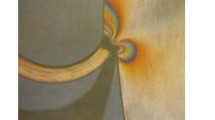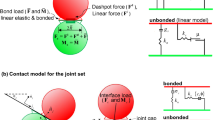Abstract
The deformation and failure behaviors of rock play an important role in rock engineering, such as tunneling engineering, geothermal exploitation, and slope treatment; nevertheless, small-scale direct tension studies still face difficulties. To investigate the small-scale tensile properties of rock, by use of a microscope mechanical test system, we conducted systematic direct tension tests on granite, marble, and a 3D printing material, for which specifically designed dogbone specimens are used. The results show that the tensile strength is less than that obtained by the Brazilian disc test and is closer to the true value, which reflects the advantage of the small-scale direct tension test. Among all the materials, the 3D printing material exhibits low discreteness. Furthermore, the printing angle has a large effect on the tensile strength of the 3D printing material. To further investigate the failure mechanism, we reproduced the experimental results via the lattice spring model (LSM). By introducing a discontinuous surface, an adjustment coefficient, and four cohesive zone models into the LSM, the elastic modulus, tensile strength, and nonlinearity in the failure stage agreed well with the experimental result. In addition, we also conducted a cyclic direct tension test and numerical simulations. Our small-scale experimental and numerical results provide a supplement to the deep understanding of rock deformation and failure. The combination of small-scale experiments and numerical simulations strengthens the understanding of rock behavior and failure processes under tensional loading.




















Similar content being viewed by others
Abbreviations
- \(A^{D}\) :
-
The representative area of spring bond
- \(c^{J}\) :
-
The cohesion of joint
- D :
-
The diameter of the specimen
- \(D_{\alpha } (u^{3D} )\) :
-
The damage variable of spring bond
- E :
-
Elastic modulus
- F :
-
Particle force
- \({\mathbf{F}}_{ij}\) :
-
The force from particle i to particle j
- \(\Delta F\) :
-
The difference in tension force between two images
- H :
-
The height of the specimen
- k :
-
Spring stiffness
- \(k_{n}^{D}\) :
-
The normal spring stiffness
- \(k_{s}^{D}\) :
-
The shear spring stiffness
- l :
-
The length of spring
- \(l_{AB}\) :
-
The distance between cross-section A and B
- \(l_{i}\) :
-
The length of the ith spring
- m :
-
The mass of a particle
- \({\mathbf{n}}_{ij}\) :
-
The normal vector from particle i to particle j
- P :
-
The force of rock failure
- \(S\) :
-
The area of the cross-section
- t :
-
Time
- \(\Delta t\) :
-
Time step
- \(u\) :
-
The deformation of spring
- \(u_{dl}^{n}\) :
-
The dilation component of normal deformation
- \(u^{*}\) :
-
Ultimate deformation
- \(u^{^{\prime}}\) :
-
The ultimate tensile deformation
- \(u_{revised}^{*}\) :
-
The ultimate deformation after adjustment
- V :
-
Volume
- \(V_{P}\) :
-
The P-wave velocity
- x :
-
The position of a mass point
- \({\mathbf{x}}^{0}\) :
-
The corresponding initial position
- \(X_{a}\) :
-
Pixel a
- \(X_{b}\) :
-
Pixel b
- \(\alpha\) :
-
A constant in damage function
- \(\beta\) :
-
Dimensionless parameter
- \(\delta_{1}\) :
-
The coefficient of peak deformation
- \(\delta_{2}\) :
-
The coefficient of post-peak turning-point deformation
- \(\gamma\) :
-
The ratio of the strength turning point
- \(\xi\) :
-
Adjustment coefficient
- \(\sigma_{c}\) :
-
Uniaxial compressive strength
- \(\sigma_{t}\) :
-
Tensile strength
- \(\sigma_{t}^{J}\) :
-
The tensile strength of joint
- \(\lambda^{4D}\) :
-
The 4D stiffness ratio
- \(\rho\) :
-
Density
- \(\eta\) :
-
The second-order polynomial equation
- \(\varphi^{J}\) :
-
The friction angle of joint
- \(\upsilon\) :
-
Poisson’s ratio
References
Aliabadian Z, Zhao G, Russell AR (2019a) Failure, crack initiation and the tensile strength of transversely isotropic rock using the Brazilian test. Int J Rock Mech Min Sci. https://doi.org/10.1016/j.ijrmms.2019.104073
Aliabadian Z, Zhao G, Russell AR (2019b) Crack development in transversely isotropic sandstone discs subjected to Brazilian tests observed using digital image correlation. Int J Rock Mech Min Sci. https://doi.org/10.1016/j.ijrmms.2019.04.004
Dai F, Xia K, Zuo J, Zhang R, Xu N (2013) Static and dynamic flexural strength anisotropy of barre granite. Rock Mech Rock Eng 46(6):1589–1602
Gong Q, Yin LJ, Wu SY, Zhao J, Ting Y (2012) Rock burst and slabbing failure and its influence on TBM excavation at headrace tunnels in Jinping II hydropower station. Eng Geol 124:98–108
Hart RD, Cundall PA, Lemos JV (1988) Formulation of a three-dimensional distinct element model - Part II. Mechanical calculations for motion and interaction of a system composed of many polyhedral blocks. Int J Rock Mech Min Sci 25(3):117–125
Hawkes I, Mellor M, Gariepy S (1973) Deformation of rocks under uniaxial tension. Int J Rock Mech Min Sci 10(6):493–507
Ishutov S, Hasiuk F, Harding C, Gray JN (2015) 3D printing sandstone porosity models. Interpretation-J Sub 3(3):SX49–SX61
Jiang C, Zhao G (2015) A preliminary study of 3D printing on rock mechanics. Rock Mech Rock Eng 48(3):1041–1050
Jiang C, Zhao G, Zhu JB, Zhao Y, Shen L (2016) Investigation of dynamic crack coalescence using a gypsum-like 3D printing material. Rock Mech Rock Eng 49(10):3983–3998
Ju Y, Wang L, Xie H, Ma G, Zheng Z, Mao L (2017) Visualization and transparentization of the structure and stress field of aggregated geomaterials through 3D printing and photoelastic techniques. Rock Mech Rock Eng 50(6):1383–1407
Kaklis KN, Maurigiannakis S, Agioutantis Z, Istantso C (2009) Influence of specimen shape on the indirect tensile strength of transversely isotropic dionysos marble using the three-point bending test. Strain 45(5):393–399
Karpuz C, Kocyigit A, Tutluoglu L, Duzgun HS, Kocal A, Erdem E, Alkilicgil C (2006) Türkiye Kömür İşletmeleri Kurumu TKİ, Orhaneli İşletmesi Açık Ocakları Panolarında Şev Tasarımı ve Dragline Çalışma Sisteminin Belirlenmesi. Middle East Technical University, Department of Mining Engineering, Ankara
Kassner ME, Nematnasser S, Suo Z, Bao G, Barbour JC, Brinson LC, Van Swol FB (2005) New directions in mechanics. Mech Mater 37(2):231–259
Kusui A, Villaescusa E, Funatsu T (2016) Mechanical behaviour of scaled-down unsupported tunnel walls in hard rock under high stress. Tunn under Sp Tech 60:30–40
Li D, Wong LN (2013) The brazilian disc test for rock mechanics applications: review and new insights. Rock Mech Rock Eng 46(2):269–287
Li H, Zhang J, Shao W, Li J (2002) Mechanical properties of Bukit Timah granite under dynamic tension. Rock Soil Mech 23(S1):1–4
Li Q, Zhao G, Lian J (2019a) A fundamental investigation of the tensile failure of rock using the three-dimensional lattice spring model. Rock Mech Rock Eng 52(7):2319–2334
Li Q, Zhao G, Lian J (2019b) Further development of the distinct lattice spring model for quasi-brittle crack propagation in concrete and its application in underground engineering. Tunn under Sp Tech 92:103061
Li W, Yin J (1998) A method for measuring both tensile and compressive elastic modulus of rock-like material. Rock Soil Mech 19(3):93–96
Liao ZY, Zhu JB, Tang CA (2019) Numerical investigation of rock tensile strength determined by direct tension, Brazilian and three-point bending tests. Int J Rock Mech Min Sci 115:21–32
Liu GT, Gao H, Chen FQ (2002) Microstudy on creep of concrete at early age under biaxial compression. Cement and Concrete Res 32(12):1865–1870
Liu P, Ju Y, Ranjith PG, Zheng Z, Wang L, Wanniarachchi A (2016) Visual representation and characterization of three-dimensional hydrofracturing cracks within heterogeneous rock through 3D printing and transparent models. Int J Coal Sci Tech 3(3):284–294
Martin CD (1997) Seventeenth Canadian geotechnical colloquium; the effect of cohesion loss and stress path on brittle rock strength. Can Geotech J 34(5):698–725
Ni X, Zhu Z, Zhao J, Li D, Feng X (2009) Meso-damage mechanical digitalization test of complete process of rock failure. Rock Soil Mech 30(11):3283–3290
Okubo S, Fukui K (1996) Complete stress-strain curves for various rock types in uniaxial tension. Int J Rock Mech Min Sci 33(6):549–556
Okubo S, Fukui K, Qingxin Q (2006) Uniaxial compression and tension tests of anthracite and loading rate dependence of peak strength. Int J Coal Geol 68(3):196–204
Stimpson B, Chen R (1993) Measurement of rock elastic moduli in tension and in compression and its practical significance. Can Geotech J 30(2):338–347
Song Y, Zeng Q, Yang Z, Liu Y, Zhong Z (2008) Roof sheet-like peeling for cave No. 35 of Huanshan Riddle Grottos in Tunsi, Anhui province. Geotech Invest Survey 8:1–4
Sufian A, Russell AR (2013) Microstructural pore changes and energy dissipation in Gosford sandstone during pre-failure loading using X-ray CT. Int J Rock Mech Min Sci 57:119–131
Sun Q, Xue L, Zhu S (2015) Permeability evolution and rock brittle failure. Acta Geophys 63(4):978–999
Wittmann FH, Rokugo K, Bruhwiler E, Mihashi H, Simonin P (1988) Fracture energy and strain softening of concrete as determined by means of compact tension specimens. Mater Struct 21(1):21–32
Xu J, Peng S, Ying G, Yang H, Wang W, Wang L (2011) Development of meso-shear test equipment for coal rock containing gas and its application. Chinese J Rock Mech Eng 30(4):35–43
Xing Y, Zhang G, Luo T, Jiang Y, Ning S (2019) Hydraulic fracturing in high-temperature granite characterized by acoustic emission. J Petrol Sci Eng 178:475–484
Yang G, Cai Z, Zhang X, Fu D (2015) An experimental investigation on the damage of granite under uniaxial tension by using a digital image correlation method. Opt Laser Eng 73:46–52
Yang T, Wang B, Gao Q, Li X (2004) Study on bending tensile test of rock samples. Site Invest Sci Technol 6:3–5
Zhang D, Luo M, Han Y (2006) A test system for mechanical behavior of materials in microscale. J Exp Mech 5:651–654
Zhao B, Liu D, Xue K (2011) Experimental study on direct tension properties of red sandstone in Chongqing. Geotech Invest Surv 39(4):9–12
Zhang S, Miao X, Zhao H (1999) Influence of test methods on measured results of rock tensile strength. J China Univ Min Tech 28(3):243–246
Zhang Y, Sun Q, He H, Cao L, Zhang W, Wang B (2017) Pore characteristics and mechanical properties of sandstone under the influence of temperature. Appl Therm Eng 113:537–543
Zhao G (2015) Modelling 3D jointed rock masses using a lattice spring model. Int J Rock Mech Min Sci 78:79–90
Zhao G (2017) Developing a four-dimensional lattice spring model for mechanical responses of solids. Comput Method Appl M 315:881–895
Zheng Z, Kemeny J, Cook NGW (1989) Analysis of Borehole Breakouts. J Geophys Res 94:7171–7182
Acknowledgements
This research was financially supported by the National Key R&D Program of China (Grant No. 2018YFC0406804), the National Natural Science Foundation of China (Grant No. 51979187), and the Natural Science Foundation of Tianjin, China (Grant No. 19JCZDJC39400).
Author information
Authors and Affiliations
Corresponding authors
Additional information
Publisher's Note
Springer Nature remains neutral with regard to jurisdictional claims in published maps and institutional affiliations.
Rights and permissions
About this article
Cite this article
Zhao, GF., Zhang, Y., Hou, S. et al. Experimental and Numerical Studies on Small-Scale Direct Tension Test for Rock. Rock Mech Rock Eng 55, 669–690 (2022). https://doi.org/10.1007/s00603-021-02683-w
Received:
Accepted:
Published:
Issue Date:
DOI: https://doi.org/10.1007/s00603-021-02683-w




